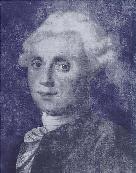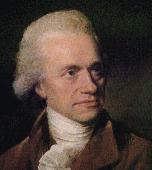


2.1. Early days
The first written reference to a cluster of galaxies is probably that of the French astronomer Charles Messier [303] in 1784. In his Catalogue des nébuleuses et des amas d'étoiles que l'on découvre parmi les étoiles fixes, sur l'horizon de Paris, he listed 103 nebulæ, 30 of which we now identify as galaxies (1). Messier already noticed the exceptional concentration of nebulæ in the Virgo constellation. However, Messier's interest in nebulæ was very marginal. He seeked to define the positions of nebulæ in order not to misidentify them with new comets (2).

| 
|
Figure 1. Portraits of C. Messier (left) and F. Wilhelm Herschel. | |
F. Wilhelm Herschel had a quite different approach to the investigation of nebulæ. German born, he escaped from Hanover and reached England during the War of the Seven Years. A musician, he became interested in astronomy after reading a popular book. After the first successful discoveries (3) with his self-made telescopes, the king of England granted him the money to build the largest telescope of his times, a 1.47 m aperture, 12.2 m focal length refractor. Herschel was interested in what we would now call the Large Scale Structure of the Universe. In 1785 he published On the Construction of the Heavens [214], where he suggested that the ``sidereal system we inhabit'' is a nebula, common in appearance to many others, which therefore must be external to our own. Most relevant here is W. Herschel's description of the Coma cluster of galaxies:
``that remarkable collection of many hundreds if nebulæ which are to be seen in what I have called the nebulous stratum of Coma Berenices''
In the same paper, W. Herschel mentioned her sister's discovery of the second small companion of M 31, NGC 205. With M 32, these three galaxies make a triplet similar to that composed by the Milky Way and the two Magellanic clouds. The other giant galaxy in the Local Group, M 33 was listed in Messier's catalogue. So, 7 members of the Local Group of galaxies were already known at that time. Their distances being unknown, it was only in 1936 that E. Hubble [233] pointed out that these galaxies (and a few more) belong to the same system, which he named ``The Local Group'' (see, e.g., van den Bergh [480]).
In the course of his life, W. Herschel [215] classified some 2500 nebulæ and recognized several other nearby clusters and groups of galaxies, such as Leo, Ursa Major, Hydra, NGC 4169, etc. His work was continued by his son, John F.W. Herschel. J. Herschel surveyed the southern sky from Cape of Good Hope, and catalogued over 6000 nebulæ that in 1864 he collected in his General Catalogue of Nebulæ and Clusters of Stars. During the first part of the XIX century, J. Herschel noted that the northern hemisphere has an excess of nebulæ with respect to the southern hemisphere, and he recognized several concentrations of nebulæ (in Pisces and Fornax, in particular). He already hinted at the existence of the Local Supercluster, with the Virgo concentration ``being regarded as the main body of this system'', and our own Galaxy ``placed somewhat beyond the borders of its densest portion, yet involved among its outlying members'' (see, e.g., Flin [164]).
In J. Herschel's times, d'Arrest [119] and Proctor [364] published new positions and finding charts of nebulæ in the Coma and Virgo clusters, Stephan [433] discovered the famous galaxy quintet, and Dreyer [148] published his New General Catalogue. Complemented by the Index Catalogues, the NGC listed roughly 13000 nebulæ in 1908.
At the beginning of the new century, the extensive photographic work of Max Wolf [500, 501, 502] led to a detailed description of the Coma and Perseus clusters. In 1918 Curtis [117] added more nebulæ to Wolf's list, reaching a total of 300 nebulæ in the Coma cluster.
In the early years of the XX century, intensive photographic observations of nebulæ were done mostly with the aim of establishing whether they were external to our own galaxy or not. The Great Debate on the nature of nebulæ between Shapley and Curtis, took place on April, 26th 1920, with no clear winner. Not only were astronomers trying to determine the distribution of nebulæ with respect to the galactic plane, they were also trying to count them! Curtis [118]' estimate of 722,000 nebulæ in 1918, was revised to 60 millions by Hubble [233] in 1936.
In 1904 Easton [150] noted an asymmetry in the distribution of the nebulæ with respect to the galactic plane, with an excess of nebulæ in the northern hemisphere. Nineteen years later, this asymmetry was re-discovered by Reynolds [371, 372] who noted that
``many of the spirals 10' diameter and upwards lie along 100°, and form part of a well-marked band of nebulæ passing over the north galactic pole, which comes out conspicuously if the spirals ranging down to 2' diameter are plotted together.''
A clear reference to the Local Supercluster! In the same years, C. Wirtz, using Dreyer's catalogues and Curtis' surveys, called the attention to several conspicuous well-defined centers of clustering (see, e.g., Abell [15]).
In the early twenties, Edwin Hubble discovered cepheids in M31, and definitely established the extragalactic nature of nebulæ. A few years later he published his work [232] on the velocity-distance relation for extragalactic nebulæ. Extending this relation to higher redshifts became the main driver for Hubble & Humason's great observational work on extragalactic nebulæ [234]. In 1934 and 1936 Milton Humason [236, 237] measured velocities of 39,200 km/s and 42,000 km/s for galaxies in the Boötis and Ursa Major II clusters, making them the most distant clusters known at that time.

|
Figure 2. Galactic distribution of the clusters of anagalactic nebulæ. From Lundmark (1927). |
More galaxy systems were discovered in those years: Cancer, Hercules, Leo, and notably the ``Centaurus cloud'', today's Shapley concentration (see, e.g., Bardelli et al. [52]). Shapley [414] correctly estimated it to be 14 times more distant than Virgo, and 10 times as rich in nebulæ. All these discoveries were serendipitous; as an example, the Perseus-Pisces stratum was noted by Tombaugh [461] as ``a by-product of the extensive trans-Neptunian planet search'' which eventually led to the discovery of Pluto. Knut Lundmark [287] plotted the sky distribution of 55 clusters of ``anagalactic nebulæ'' - see Fig. 2. Coordinates of these clusters were not listed, but it is likely that many of them were groups rather than clusters. Lundmark noted ``the most characteristic feature in the charts of the nebular distribution is the clustering tendency'', a tendency confirmed in the Harvard survey [418]. While presenting results from this survey, Shapley [415] provided a list of 25 clusters and suggested the existence of ``metagalactic clouds'' (today's superclusters), such as those in Coma, Centaurus and Hercules [416]. E.F. Carpenter [96] described clusters as the extremes of a continuous non-uniform spatial distribution of galaxies, thus anticipating the works of Neyman & Scott [320] and Peebles [352].
In contrast to the growing dominant opinion, in 1936 Hubble [233] described the distribution of nebulæ as ``moderately uniform'' and noted that ``no organization on a scale larger than the great clusters'' was definitely known. However, he recognized our own Galaxy as a member of a galaxy system, which he named ``The Local Group''. Zwicky [514] noted that the local group may well be part of the Virgo galaxy system, that Holmberg [224] described as a ``Metagalactic cloud'' of ~ 100 Mpc size.
1 Of the 30 extragalactic objects in Messier's
catalogue, only 13 are listed in the Virgo Cluster Catalogue of
Binggeli et al.
[63].
Back.
2 Charles Messier was nicknamed ``le
furet des comètes'' by Louis XV.
Back.
3W. Herschel became very famous
after his discovery of Uranus in 1781. Back.